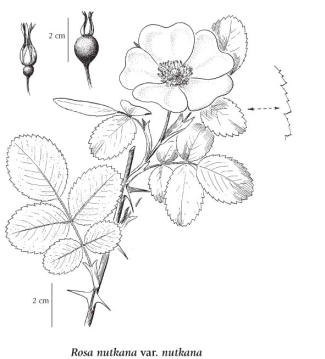Nootka rose
Rosaceae (Rose family)
Introduction to Vascular Plants
Map
Distribution of Rosa nutkana var. nutkana
Click here to view the full interactive map and legend
Species Information
General:
Medium to tall shrub 0.5-3 m tall, spreading by rhizomes and often thicket-forming; stems stout to spindly, erect to arching, with a pair of large prickles (thorns) at each node, usually lacking internodal prickles; mature stems blackish.
Leaves:
Alternate, deciduous, odd-pinnately compound, the leaf-stalk and axis glandular-hairy or short-hairy; leaflets 5 or 7 (9), elliptic to egg-shaped, 1-7 cm long, coarsely single- or double-toothed, somewhat glandular-short-hairy beneath; stipules usually glandular-blunt-toothed.
Flowers:
Inflorescence of usually single, sometimes 2 or 3, stalked flowers on lateral branchlets; corollas pink, saucer-shaped, large (4-8 cm across), the petals 5, (2) 2.5-4 cm long; calyces smooth or glandular-bristly, 5-lobed, the lobes lanceolate, 1.5-4 cm long, long-tapering and narrowing then flaring below the tip, persistent; ovaries superior but enclosed in the urn-shaped floral tube (hypanthium); stamens numerous.
Fruits:
Achenes, numerous, stiffly long-hairy on one side, enclosed by the fleshy hypanthium, which ripens into a purplish-red, globe- to pear-shaped hip 1-2 cm long.
Notes:
Two varieties occur in BC:
1. Leaflets doubly saw-toothed, the teeth gland-tipped; infrastipular prickles becoming much enlarged and flattened toward base; plants mostly from west of Coast-Cascade Mountains................. var. nutkana
1. Leaflets singly saw-toothed, the teeth not gland-tiped; prickles rarely enlarged and flattened; plants mostly from east of Coast-Cascade Mountains..................var. hispida Fern.
Illustration

If more than one illustration is available for a species (e.g., separate illustrations were provided for two subspecies) then links to the separate images will be provided below. Note that individual subspecies or varietal illustrations are not always available.
Illustration Source: The Illustrated Flora of British Columbia
Ecology
The table below shows the species-specific information calculated from
original data (BEC database) provided by the BC Ministry of Forests and Range.
(Updated August, 2013)
| Site Information |
Value / Class |
||
|
Avg |
Min |
Max |
|
| Elevation
(metres) |
996 | 996 | 996 |
| Slope
Gradient (%) |
18 | 18 | 18 |
|
Aspect (degrees) |
231 | 231 | 231 |
| Soil
Moisture Regime (SMR) [0 - very xeric; 4 - mesic; 8 - hydric] |
4 | 4 | 4 |
| Modal
Nutrient Regime
Class |
D | ||
| #
of field plots species was recorded in: |
1 | ||
| Modal
BEC Zone Class |
ICH | ||
|
All BEC Zones (# of stations/zone) species was recorded in |
ICH(1) | ||
|
Source:
Klinkenberg 2013
|
|||
Habitat and Range
Mesic to moist thickets, forest edges, river terraces, shorelines, streambanks, clearings and roadsides in the lowland and montane zones; common throughout BC south of 55oN except in the Chilcotin area, infrequent northward, absent in NE BC; N to AK and S to CA, CO and UT.Synonyms
Synonyms and Alternate Names:
Rosa durandii Crép.
Taxonomic Keys
KEY TO ROSA
1. Stipules deeply fringed or comb-like; inflorescence multiflowered..........R. multiflora 1a. Prickles strongly curved, stout; calyx-lobes often with conspicuous lateral segments and usually reflexed after flowering.
2. Lower surface of leaflets stalked-glandular..............R. eglanteria 1a. Prickles not or slightly curved, often slender; calyx-lobes usually without lateral segments, usually ascending or erect after flowering.
3. Calyx-lobes deciduous in fruit, 12 mm long or less; petals 15 mm long or less...............R. gymnocarpa 4. Stems with well-defined infrastipular prickles (pair of prickles at or just below each node) or nearly unarmed.
5. Calyx-lobes usually glandular-bristly; leaflets finely toothed; plants from west of the Coast-Cascade Mountains............R. pisocarpa
6. Flowers small and clustered; calyx-lobes mostly 1-2 cm long and 2-3.5 mm wide at base; petals 1.2-2.5 cm long................R. woodsii 4. Stems more or less bristly with slender prickles; infrastipular prickles, if any, like the others.
7. Flowers mostly solitary, usually on lateral branchlets of current season; leaflets usually 5 to 7 (9); petals more than 2 cm long..................R. acicularis Source: Illustrated Flora of British Columbia (Vol. 4). (1999) |